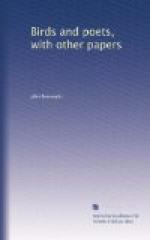How easily a bird’s tail, or that of any fowl, or in fact any part of the plumage, comes out when the hold of its would-be capturer is upon this alone; and how hard it yields in the dead bird! No doubt there is relaxation in the former case. Nature says to the pursuer, “Hold on,” and to the pursued, “Let your tail go.” What is the tortuous, zigzag course of those slow-flying moths for but to make it difficult for the birds to snap them up? The skunk is a slow, witless creature, and the fox and lynx love its meat; yet it carries a bloodless weapon that neither likes to face.
I recently heard of an ingenious method a certain other simple and slow-going creature has of baffling its enemy. A friend of mine was walking in the fields when he saw a commotion in the grass a few yards off. Approaching the spot, he found a snake—the common garter snake—trying to swallow a lizard. And how do you suppose the lizard was defeating the benevolent designs of the snake? By simply taking hold of its own tail and making itself into a hoop. The snake went round and round, and could find neither beginning nor end. Who was the old giant that found himself wrestling with Time? This little snake had a tougher customer the other day in the bit of eternity it was trying to swallow.
The snake itself has not the same wit, because I lately saw a black snake in the woods trying to swallow the garter snake, and he had made some headway, though the little snake was fighting every inch of the ground, hooking his tail about sticks and bushes, and pulling back with all his might, apparently not liking the look of things down there at all. I thought it well to let him have a good taste of his own doctrines, when I put my foot down against further proceedings.
This arming of one creature against another is often cited as an evidence of the wisdom of Nature, but it is rather an evidence of her impartiality. She does not care a fig more for one creature than for another, and is equally on the side of both, or perhaps it would be better to say she does not care a fig for either. Every creature must take its chances, and man is no exception. We can ride if we know how and are going her way, or we can be run over if we fall or make a mistake. Nature does not care whether the hunter slay the beast or the beast the hunter; she will make good compost of them both, and her ends are prospered whichever succeeds.
“If the red slayer think
he slays,
Or if the slain think he is slain,
They know not well the subtle ways
I keep, and pass, and turn again.”
What is the end of Nature? Where is the end of a sphere? The sphere balances at any and every point. So everything in Nature is at the top, and yet no one thing is at the top.
She works with reference to no measure of time, no limit of space, and with an abundance of material, not expressed by exhaustless. Did you think Niagara a great exhibition of power? What is that, then, that withdraws noiseless and invisible in the ground about, and of which Niagara is but the lifting of the finger?




